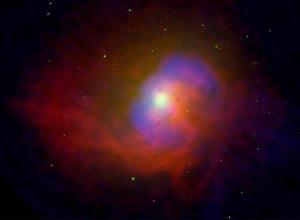Magazine issue 2725. Subscribe and get 4 free issues
when material falls toward the black hole in the centre of the galaxy NGC 4696, energy is produced as some of the matter is blasted back out in jets (Image: NASA / CXC / S.Allen (Kavli Inst., Stanford) et al; Radio in blue – NRAO / G.Taylor (VLA ); Infrared in green – NASA / ESA / W.Harris (McMaster Univ.))
WHAT will happen to fundamental physics when our descendants reach the limit of particle accelerator technology? We’ll surely run out of space and money long before the smallest building blocks of the universe can be probed with machines, because of the massive energies required.
One saviour may be the universe’s own particle smashers – black holes. If two particles are accelerating towards a rotating black hole with a certain velocity then they should collide with energies higher than anything we could hope to achieve on Earth.
The singularity at the centre of a black hole is so dense that any matter and light that reaches the black hole’s point of no return, or event horizon, gets sucked in due to the extreme gravitational attraction. The closer that particles get to the black hole, the greater the energy they have.
So could these particles smash together and perhaps reveal evidence of “new physics”? That’s what physicists Stephen West of Royal Holloway, University of London, Max Bañados of the Pontifical Catholic University of Chile in Santiago and Joseph Silk of the University of Oxford decided to investigate.
The particles they chose for their natural accelerator model were of dark matter. These weakly interacting particles are thought to collect in a dense core around middle-weight black holes as they form out of ordinary matter. They wouldn’t be the only particles around, but….
We highly recommend New Scientist magazine . Click on the link for the complete article.

